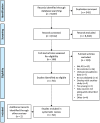A systematic review of the biological, social, and environmental determinants of intellectual disability in children and adolescents
- PMID: 36090348
- PMCID: PMC9453821
- DOI: 10.3389/fpsyt.2022.926681
A systematic review of the biological, social, and environmental determinants of intellectual disability in children and adolescents
Abstract
Aim: This systematic review aimed to identify the most important social, environmental, biological, and/or genetic risk factors for intellectual disability (ID).
Methods: Eligible were published prospective or retrospective comparative studies investigating risk factors for ID in children 4-18 years. Exclusions were single group studies with no comparator without ID and a sample size <100. Electronic databases (Medline, Cochrane Library, EMBASE, PsycInfo, Campbell Collaboration, and CINAHL) were searched for eligible publications from 1980 to 2020. Joanna Briggs Institute critical appraisal instruments, appropriate for study type, were used to assess study quality and risk of bias. Descriptive characteristics and individual study results were presented followed by the synthesis for individual risk factors, also assessed using GRADE.
Results: Fifty-eight individual eligible studies were grouped into six exposure topics: sociodemographic; antenatal and perinatal; maternal physical health; maternal mental health; environmental; genetic or biological studies. There were few eligible genetic studies. For half the topics, the certainty of evidence (GRADE) was moderate or high.
Conclusion: Multiple studies have examined individual potential determinants of ID, but few have investigated holistically to identify those populations most at risk. Our review would indicate that there are vulnerable groups where risk factors we identified, such as low socioeconomic status, minority ethnicity, teenage motherhood, maternal mental illness, and alcohol abuse, may cluster, highlighting a target for preventive strategies. At-risk populations need to be identified and monitored so that interventions can be implemented when appropriate, at preconception, during pregnancy, or after birth. This could reduce the likelihood of ID and provide optimal opportunities for vulnerable infants.
Systematic review registration: [https://www.crd.york.ac.uk/prospero/display_record.php?RecordID=120032], identifier [CRD42019120032].
Keywords: antenatal; data linkage; intellectual disability; maternal health; population data; risk factor; sociodemographic; systematic review.
Copyright © 2022 Leonard, Montgomery, Wolff, Strumpher, Masi, Woolfenden, Williams, Eapen, Finlay-Jones, Whitehouse, Symons, Licari, Varcin, Alvares, Evans, Downs and Glasson.
Conflict of interest statement
The authors declare that the research was conducted in the absence of any commercial or financial relationships that could be construed as a potential conflict of interest.
Figures
References
-
- Schalock R, Borthwick-Duffy S, Bradley V, Buntinx W, Coulter D, Craig E, et al. Intellectual Disability: Definition, Classification, and Systems of Supports. 11th ed. Washington, DC: American Association on Intellectual and Developmental Disabilities; (2010).
-
- Luckasson R, Coulter D, Polloway E, Reiss S, Schalock R, Snell M, et al. Mental Retardation: Definition, Classification, and Systems of Supports. Washington DC: American Association on Mental Retardation; (1992).
-
- American Psychiatric Association. Diagnostic and Statistical Manual of Mental Disorders. 5th ed. Washington, DC: Author; (2012). 10.1176/appi.books.9780890425596 - DOI
Publication types
LinkOut - more resources
Full Text Sources


